Colorful and friendly-looking, orange monkeys are some of the rarest types of monkeys in the world.
While many species are orange, their numbers may be small compared to those of some of the darker monkeys in the world.
Interestingly, some species are only orange as juveniles, typically up to a few months. Researchers don’t know why these monkeys are orange as newborns.
Other types of monkeys are orange even as adults. Most are diurnal and known for living in groups.
From South America to the remote islands of Indonesia, the following species of monkeys are dominated by orange nuances to some extent.
Table of Contents
1. Golden Lion Tamarin
Golden Lion Tamarins (Leontopithecus rosalia) are orange or orange-red across the head, body, legs, and tails.
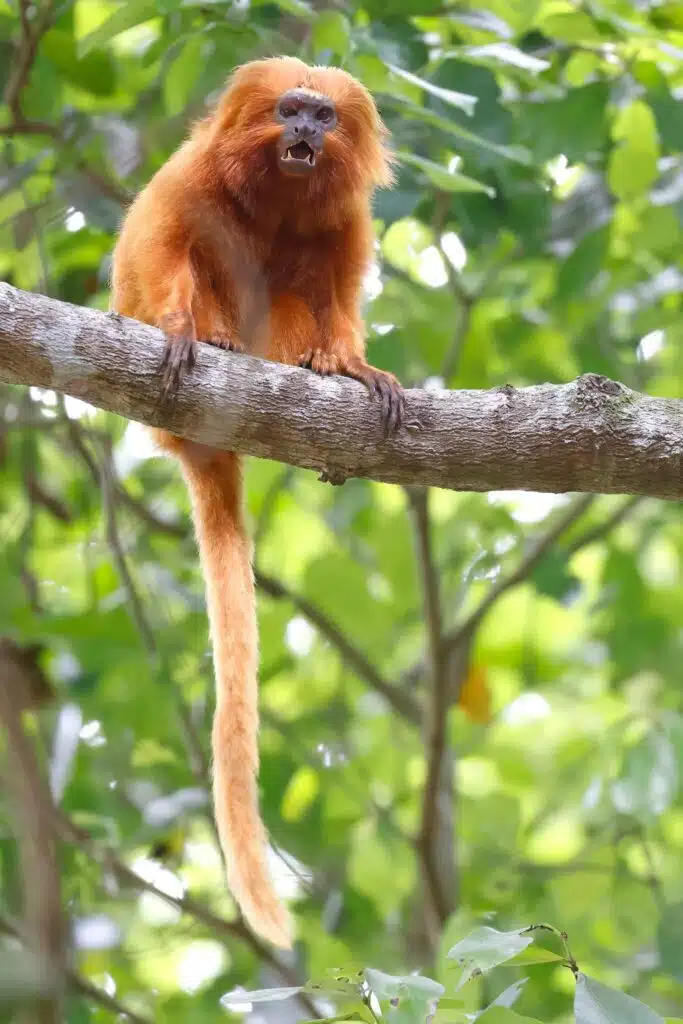
These are some of the most vivid types of monkeys but have slight nuance differences between the sexes.
Males have a darker orange nuance or orange-red nuances while females are brighter and have a yellow-orange appearance.
While they look apart, these monkeys are endangered. There are only a few thousand Golden Lion Tamarins left in remote areas of Southern Brazil.
These orange monkeys grow to about 10 inches and are known for being quite active.
Half of the day is spent awake and looking for a new sleeping spot as they never sleep in the same location night after night.
Golden Lion Tamarins live in small mixed groups with more males or more females, depending on the situation.
Groups with multiple males are dominated by an alpha male which is often challenged by other males in the group.
A dominant female also exists in the group and dominancy is achieved by the eldest of the group.
Offspring are also part of the group and may be raised by multiple females if the group has multiple females.
Not much changes in the dynamics of a group until the death of a leader. Other males only enter groups as leaders or soon-to-be leaders when they challenge the current leader and succeed or when the alpha male dies.
2. Central American Squirrel Monkey
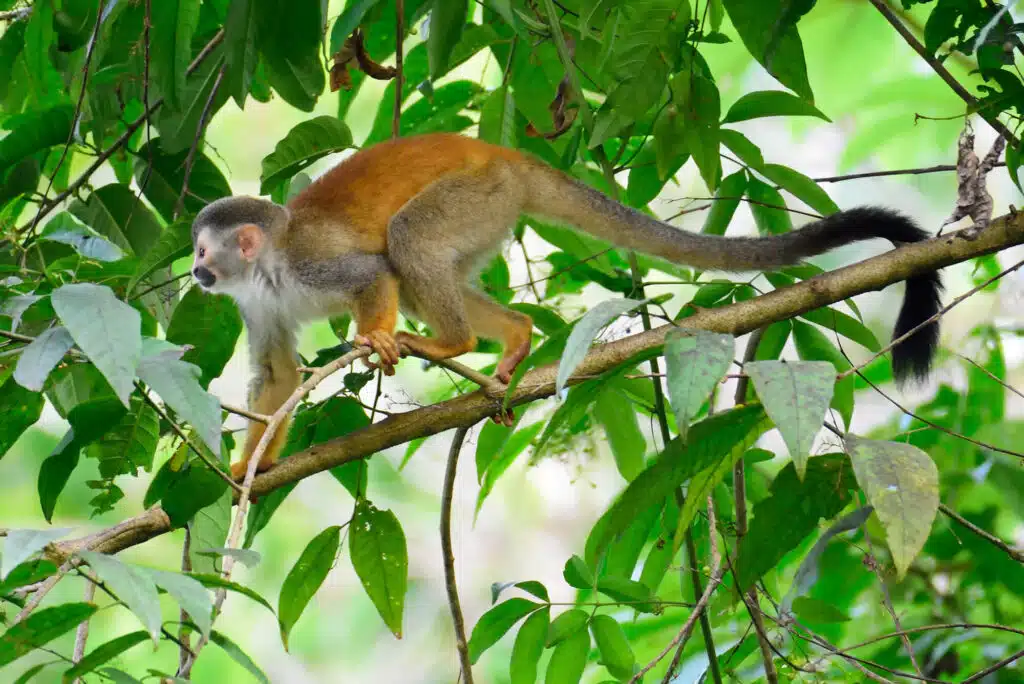
Central American Squirrel Monkeys (Saimiri oerstedii) also grow to a size of up to 11 inches and are dominated by orange nuances across their backs.
A dark orange dorsum is seen on this species which additionally shows a white face with a black mouth, black eyes, and black brows.
These small monkeys live in some of the larger groups among Central American species.
A Central American Squirrel Monkey troop may count up to 75 individuals which remain together for years.
A typical monkey of the species lives up to 15 years, typically part of the same group.
Unlike most other monkeys, these mixed groups are less defined by hierarchy.
All females within the group are equal. Males are also equal up until breeding privileges where an alpha male breeds first.
The groups themselves tend to be dominated by females in numbers.
Low aggression is also characteristic of male-male relationships within the group.
Males of a troop may also be related, which explains the rather peaceful nature of a troop.
Living in dense forests, these monkeys make some of the highest-pitched sounds of all New World monkeys.
They can chirp, whistle, and make squeaking noises which are all tied to a certain event.
3. Colombian Red Howler Monkey
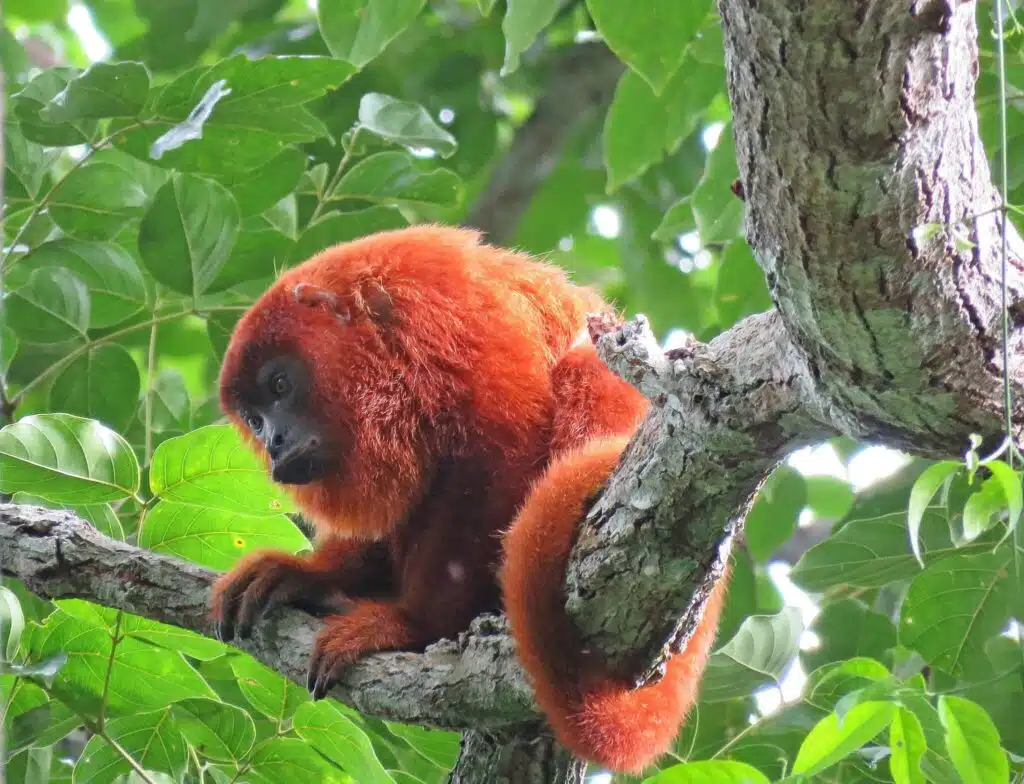
A red-brown color or a deep orange color is specific to the highly common Colombian Red Howler Monkey (Alouatta seniculus).
With a considerable presence in Northeastern South America, this is one of the species that is classified as of least concern.
Its colorful appearance is uniform but there’s also a black face the species is known for. Its black face is hairless.
These types of monkeys are folivores or monkeys that eat leaves. They rely on leaves so much they may not even survive without them for more than a few days.
While the diet of these colorful monkeys isn’t based on leaves alone, young and old leaves are their favorite foods.
To survive on leaves, these monkeys have evolved into having the capacity to digest them.
Not all monkeys can digest leaves but their digestive system is adapted to breaking them down quickly.
Most of their days are spent up on trees so they don’t have to move far for good leaves as well.
While these monkeys are social and mostly live in small groups, they can also move away in pairs to live on their own.
4. Maroon Leaf Monkey

Also known as The Red Leaf Monkey, Maroon leaf Monkeys (Presbytis rubicunda) have darker males and mostly orange females.
They also show black hairless faces both in the case of males and females.
These types of monkeys are rare as they only live in Borneo. Their insular habitat is represented by rainforests and evergreen thick forests where they spend their days up on trees.
Together with their orange subspecies, Maroon Leaf Monkeys are known to feed on leaves, plants, and flowers.
Much of their diet changes with the seasons. Even the leaves they eat are categorized for their juiciness and nutritional content.
These monkeys also need a bit more minerals to survive. They get these minerals from eating soil.
Not all types of soil are to their liking. As a result, they only eat the soil of termite mounds which is loose and packed with minerals.
5. Guianan Red Howler Monkey
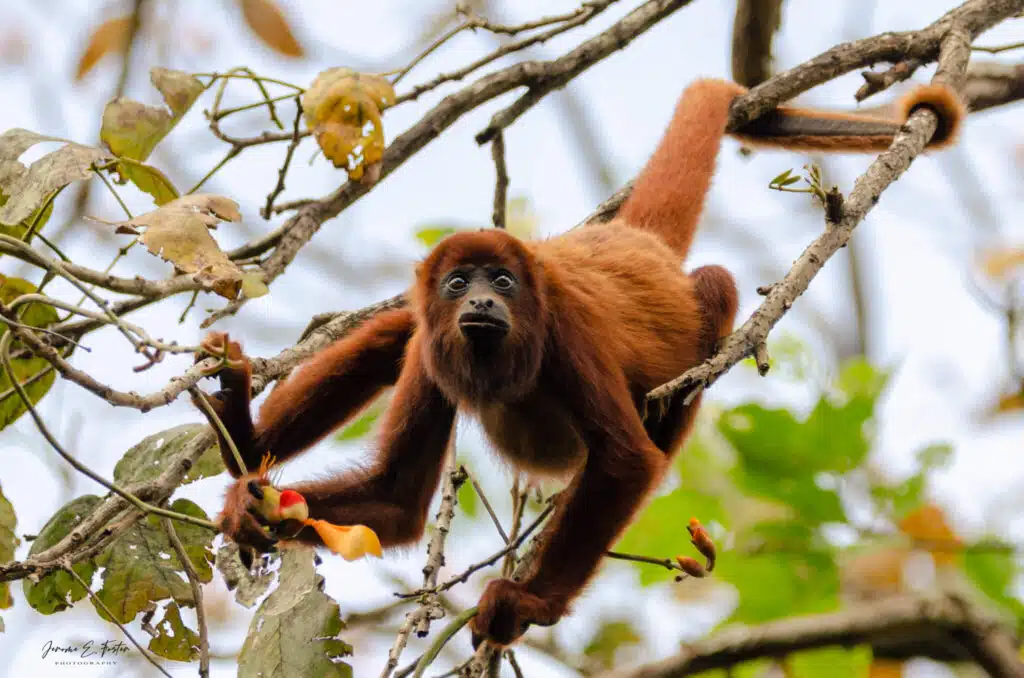
Orange sections are mostly spotted on the back of The Guaiana Red Howler Monkey (Alouatta macconnelli).
Most brown-red or orange-brown-red, this is a species with a matching tail except the tip, which is hairless.
This is an imposing type of monkey and the largest of the monkeys in South America.
It lives in dense forests in states such as Suriname where it relies on its tail which is longer than its body to move around various branches.
Monkeys of these species can appear dark when seen from the front as their ventral color is darker while their faces are black.
Orange nuances are only specific to their backs and the tail towards the hairless tip.
While large and imposing, these monkeys tend to live in smaller groups compared to other troops.
It’s not unusual to see Guaian Red Howler Monkeys in groups as small as 5 individuals, under the rule of a male.
These monkeys are further known for their loud and low-pitched howling noises.
6. Bolivian Red Howler

Red-orange hairs are specific to The Bolivian Red Howler (Alouatta sara).
Brighter and darker red-orange hairs are seen on the monkey, with brighter nuances mostly specific to the females.
This is one of the multiple howler monkeys of South America. Their larger larynges allow these monkeys to have a deep howl-like vocalization.
These types of howls are mostly specific to males which maintain territory.
Monkey howling is loud, being heard miles away. Males howl both in the morning and in the evening, to let other monkeys know their location and not to come too close.
High levels of aggression are specific between the males of various groups even between the males of the same group.
Some males may challenge the alpha male for breeding rights.
Still, it’s the female that begins the courting process by choosing the male to breed with.
Orange females of the species smack their lips in front of the male of the group they want to breed with.
7. Western Red Colobus
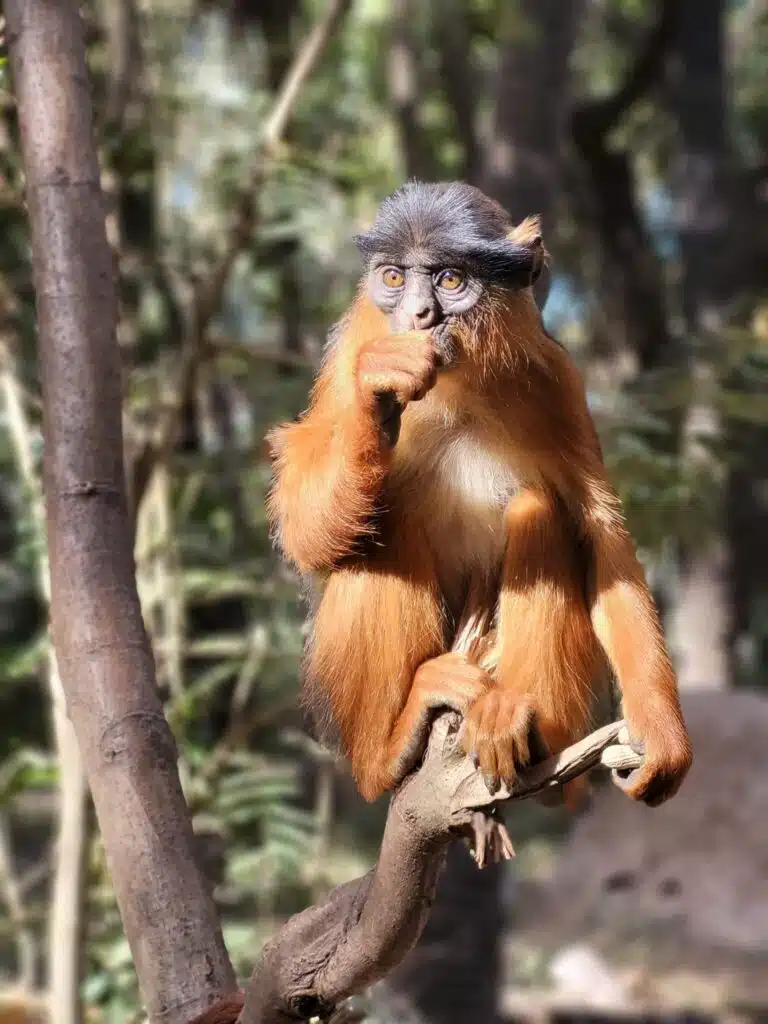
Orange-red nuances are seen on the chest, legs, and around the face of The Western Red Colobus (Piliocolobus badius).
This species additionally features black back nuance with a black cap.
In its early days, young Western Red Colobuses are considerably brighter.
They feature a gray back and bright orange nuances across the rest of the body. Slowly turning dark orange and then orange-red, these monkeys live long lives of decades.
A species already facing an endangered status, Western Red Colobuses live in the rainforests of Western Africa where they face hunting and habitat reduction.
Most of their days are spent up on trees where they feed on leaves, fruit, and seeds.
From African nutmeg to locust beans, these monkeys have sharp teeth they can penetrate different types of seeds with.
Western Red Colobuses typically live in large troops of 50 or more monkeys under hierarchic order.
8. Red-handed Howler Monkey
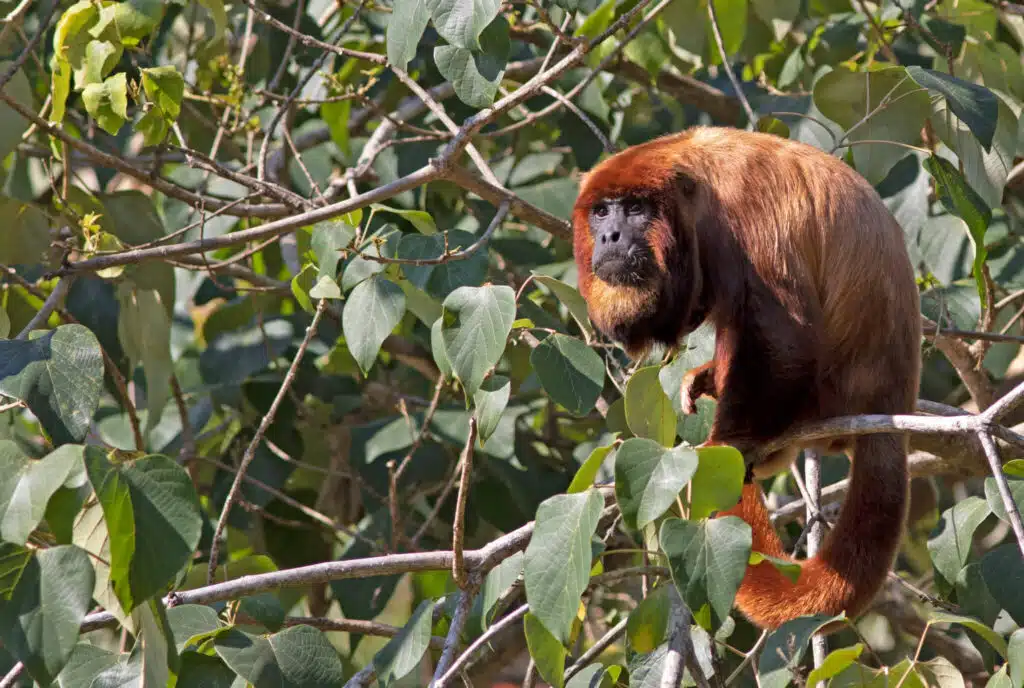
Red-handed Howler Monkeys (Alouatta belzebul) have an atypical look. While mostly black, they can have orange, brown, or red fingers or hands.
Only partly orange, Red-handed Howler Monkeys are present in Eastern Brazil where they live in large groups.
This diurnal and arboreal species is part of a wider group of howler monkeys with deep and loud vocalizations.
It also represents a species that eats both leaves and fruit. The youngest leaves are sometimes preferred, together with the ripest fruit.
Excellent vision and good species identification allow these monkeys to only pick ripe fruit without even tasting it.
Living in groups, males, and females can breed among them but males typically need to reach a higher hierarchy for breeding rights.
Females are also selective, only breeding with the healthiest males.
A beneficial ecological role is also tied to these monkeys. As they eat seeds without cracking them, they spread them around the area of the tree, essentially sprouting new tree growth by their eating habits.
9. Ursine Howler Monkey
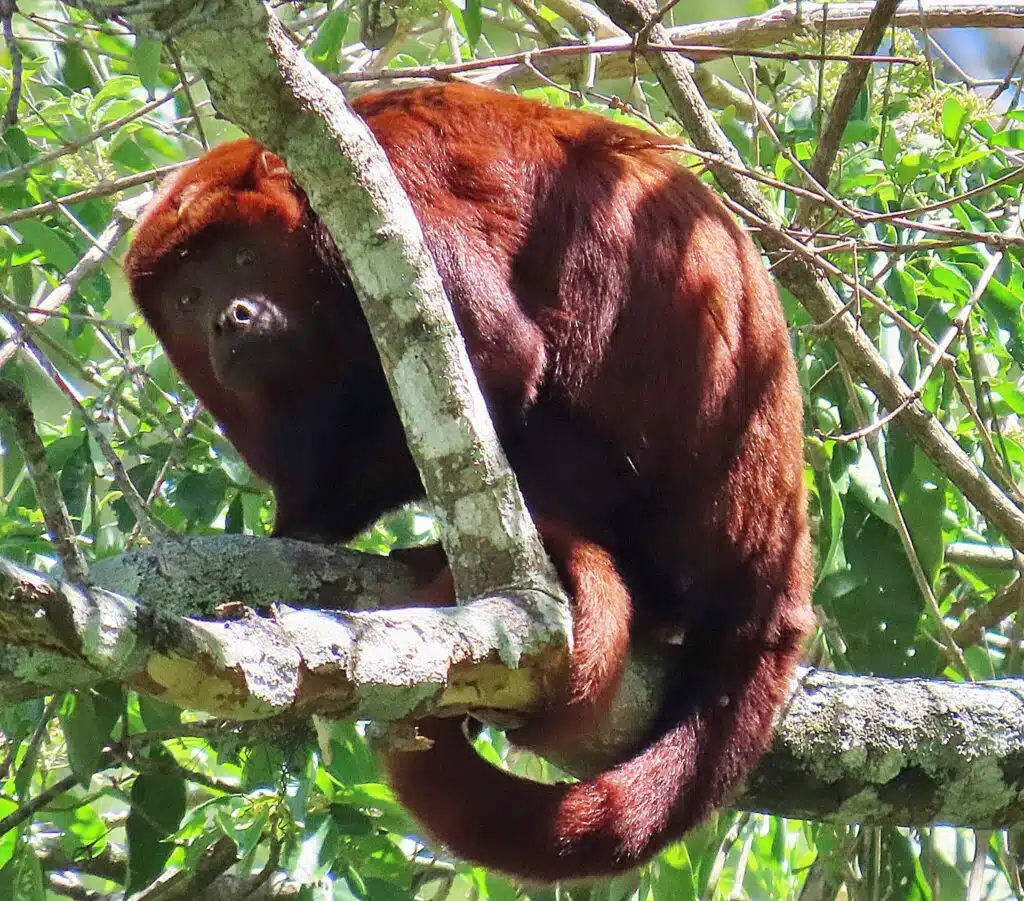
Orange-red nuances are specific to Ursine Howler Monkeys (Alouatta arctoidea). Their backs have a brighter nuance and are mostly bright orange while their heads and legs are orange-red.
Their long tails are also bi-colored with the area towards the tip being brighter orange and the area close to the body being darker orange.
A South American species, Ursine Howler Monkeys live in forests and grassland but are mainly arboreal.
Growing to a size of more than 20 inches and up to 28 inches, these are also some of the largest types of orange monkeys in South America.
Known for their vivid coloring, these monkeys with black faces are also present in Venezuela.
Some writers even see The Ursine Howler Monkey as a subspecies of the more common Venezuelan Howler Monkey.
Feeding on fruits and leaves, the species is among those with vocalizations heard up to 2 miles away, depending on the density of the forest.
Males howl 2 times per day to communicate their locations to other groups.
While the small groups of Ursine Howler Monkeys live within miles of each other, they prefer not to intersect to avoid confrontation.
10. Golden Snub-nosed Monkey

A golden-orange nuance is seen on the long hairs of The Golden Snub-nosed Monkey (Rhinopithecus roxellana).
This is a species with a white face and bright hairs also locally referred to as The Sichuan Golden Hair Monkey.
Some other typical color combinations include having a bright orange collar, a dark orange face, and a dark gray body.
These are some of the adapted monkeys when it comes to cold weather and as a result, they can live in their high habitats in China.
Food choices include fruits from dogwood and other forest trees as well as leaves, depending on the season.
Dietary choices and coat coloring can vary through the seasons, but so do their troops.
These are some of the most numerous groups of monkeys with hundreds of males forming a troop in the winter.
According to some data, it seems that small groups join large groups in the wintertime alone.
11. Madidi Titi
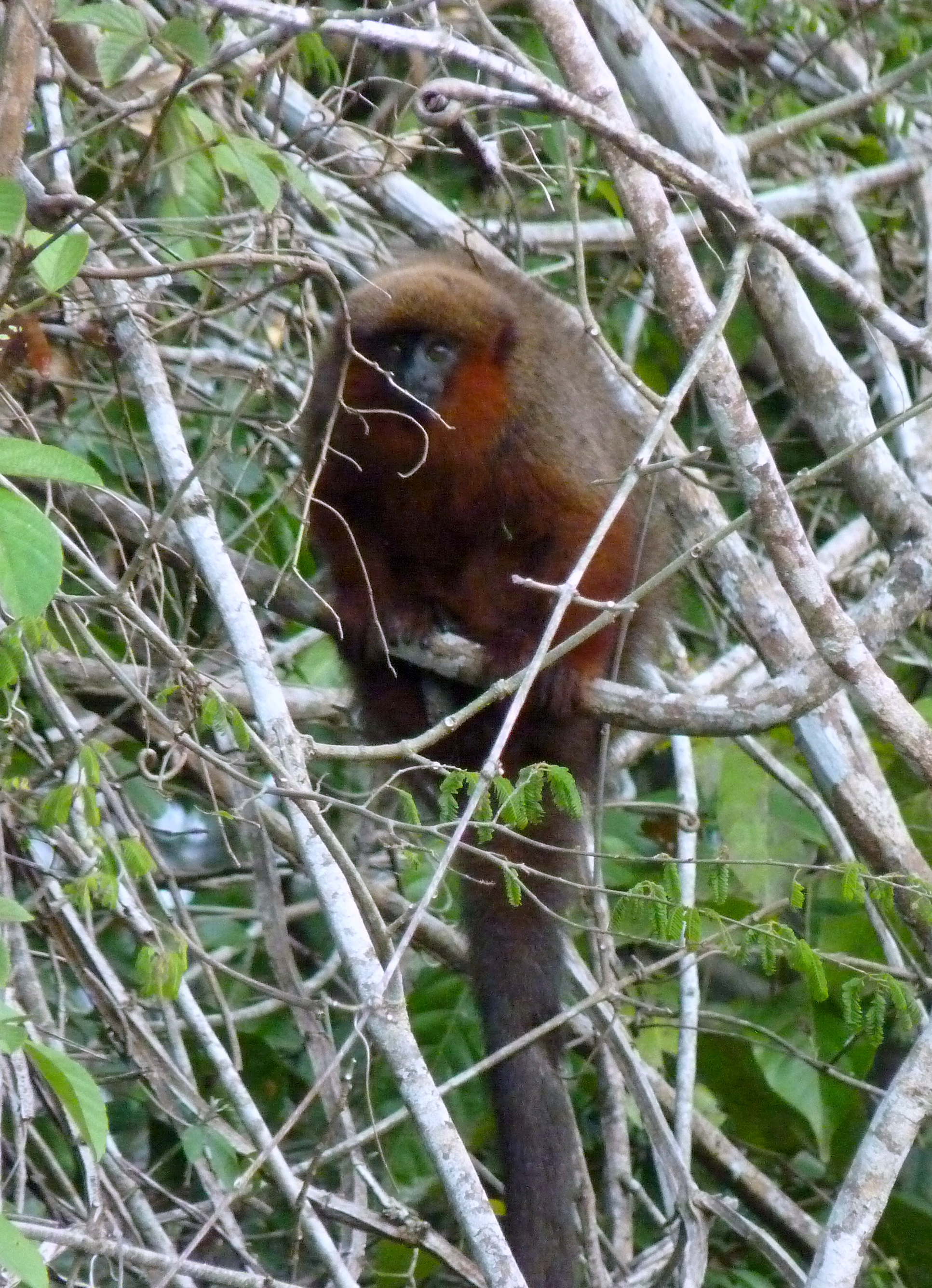
Madidi Titi monkeys (Plecturocebus aureipalatii) have a dark orange and brown appearance.
These are some of the darker natives of South America, with a tendency to live secretive lives up on trees.
Dark orange nuances are seen on its chest and belly while the back and head are dominated by darker brown hairs.
Active by day, this is one of the exceptions when it comes to relationships as it forms lifelong bonds.
Males and females form strong relationships and establish territoriality.
This leads to them sharing some of the offspring care duties and males are even known to help out as well.
Once formed, a pair maintains territory over an area with food and constantly vocalizes their presence to other monkeys in the area.
Young monkeys live with their parents once they can feed on their own.
12. Golden-mantle Saddleback Tamarin

Orange nuances dominate the chest and upper back of the Golden-mantle Saddleback Tamarin (Saguinus tripartitus).
Its front legs are also dominated by bright orange nuances while the back is gray and black.
Black and white nuances are also specific to its head. Mostly black, the head also shows a white section around the mouth.
A species of the East Andes, Golden-mantle Saddleback Tamarins also have fluffy tails that are partly orange and partly black.
Size-wise, these monkeys are small, rarely growing to a size of up to 9 inches.
Living in mixed troops, they are dominated by a single breeding female which stops other females from breeding.
Living under a hierarchic group, males and females of a troop identify the rank of others primarily by odor.
13. Dusky Leaf Monkey

Much of the appearance of Dusky Leaf Monkeys (Trachypithecus obscurus) is subject to their age.
Mostly orange as juveniles, these monkeys eventually become gray, brown, or even black.
Dark faces with white eye circles also stand out on the adult Dusky Leaf Monkey.
This is a species named after it tends to eat leaves, which it consumes in amounts of up to several pounds per day.
Dusky Leaf Monkeys cannot go more than a week without their leaves as their primary food.
Living in groups, they are under the rule of a territorial alpha male which also gets first breeding rights.
Young monkeys that grow into adult males typically move out with other males and form separate troops.
14. Brown Howler Monkey
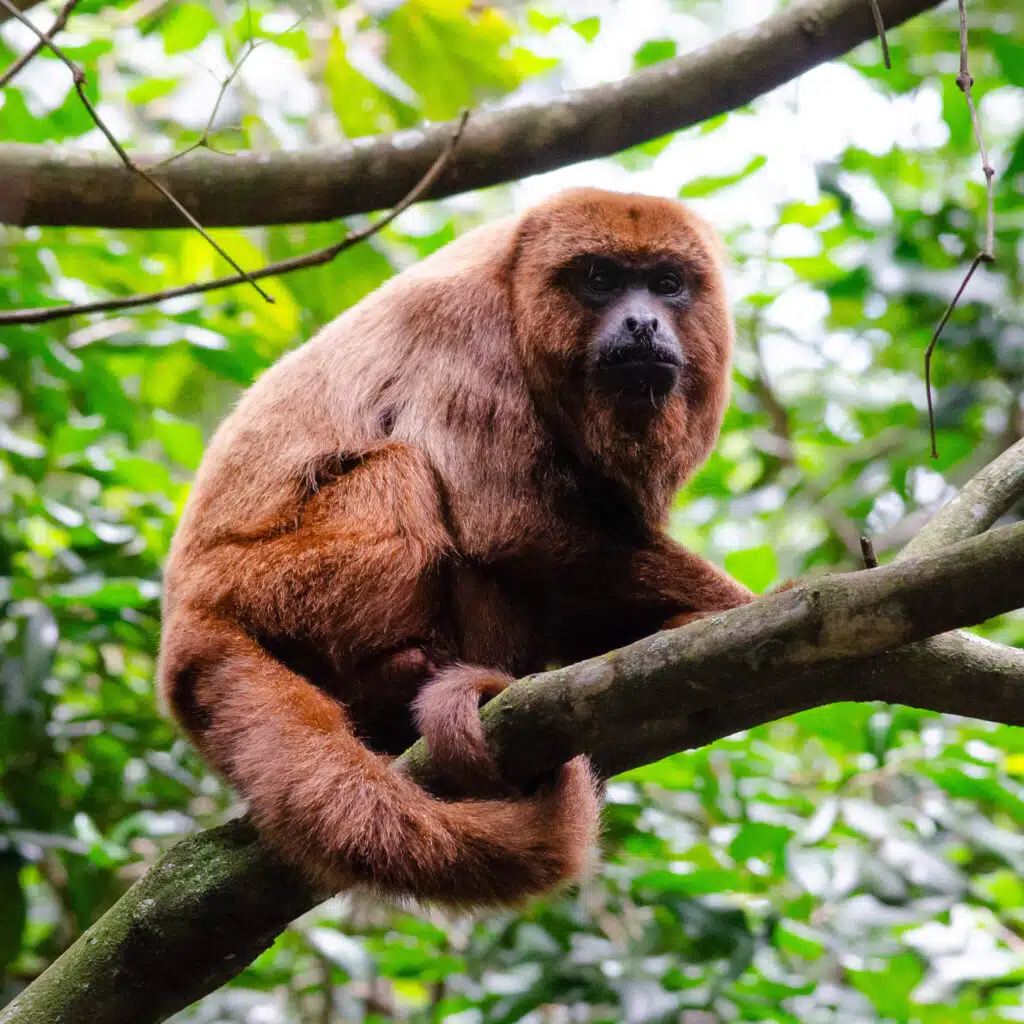
A dark red-orange appearance dominates The Brown Howler Monkey (Alouatta guariba), unlike its name implies.
Purely brown nuances on the species are rare as red-orange areas are seen on the head, lower back, legs, and belly.
Black hairless faces are also specific to Brown Howler Monkeys.
Some other types of colors are also specific to these monkeys in their juvenile days, mainly with mostly black hairs and scarce orange-red hairs.
A species of Southeastern Brazil, Brown Howler Monkeys feed on leaves and fruit. Like other howlers, they are very loud, being heard from a long distance in their native neotropical forest.
15. Proboscis Monkey
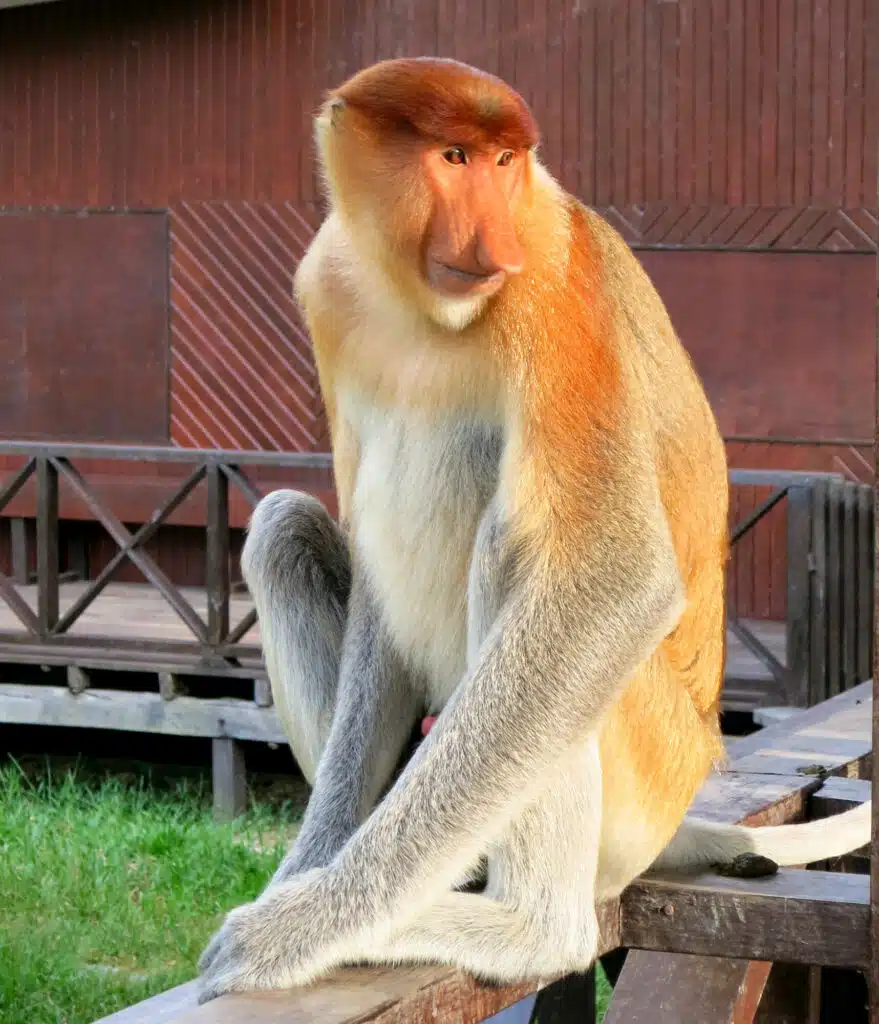
Orange and dark orange nuances are seen on the atypical long-nosed Proboscis Monkey (Nasalis larvatus).
This is a species with gray areas across the body as well.
Some color variation exists between males, females, and young Proboscis Monkeys. They can all appear as different species as females are considerably brighter orange, as are juveniles.
A species of Indonesia, the Proboscis Monkey is endangered.
Several thousand still live in the wilderness, mainly in small or medium-sized groups.
This is also a species with communication means, mainly known for its honk-like vocalizations.
They also have very specific calls for different actions and events such as spotting a threat or seeing a juvenile in a dangerous situation.
Females have vocalizations of their own. These include vocalizations for agitation or worrying.
16. Selangor Silvered Langur
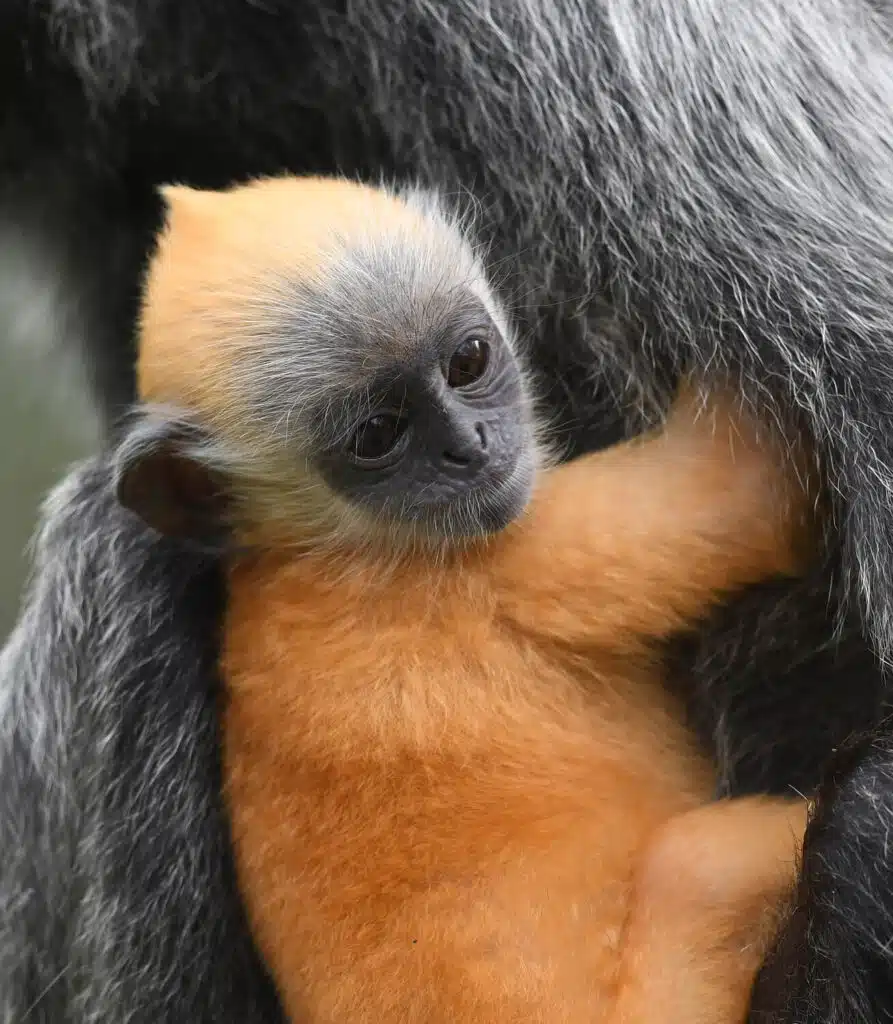
Selangor Silvered Langurs (Trachypithecus selangorensis) are born orange and remain orange for several months. As they grow, their color darkens until it becomes black and silver.
The darkening happens on one body part alone. The legs and the head become black before the body.
It’s not yet clear why the young monkeys have an orange color but all females of a group participate in raising and carrying the young.
Some evidence suggests juveniles that are orange are easier to watch out for by the adults of the groups.
The young monkeys tend to be carried by each adult in the group, taking turns. They also have juvenile-specific vocalizations.
Named after their native state in Malaysia, these types of monkeys prefer to live in forests close to water.
They are also accustomed to humans as tourists in their natural habitat and can fiercely approach asking for food.
17. Javan Lutung

An orange-brown color with yellow sections is seen on the Javan Lutung (Trachypithecus auratus), a species named after Indonesia’s Java island.
Juvenile Javan Lutungs have even brighter orange nuances but they can even remain brighter orange as adults.
This is a species that also lives on other islands of Indonesia where it maintains a diurnal activity level.
Small group living is specific to the social lives of Javan Lutungs. These are types of monkeys that live together in groups of 5-7 males and females.
Each group typically has 2 males and females may breed with both at any moment.
The result, as with Selangor Silvered Langurs is offspring that are cared for by all females within the group, sometimes even by the males.
Living in good relationships with group members, Javan Lutungs are highly aggressive towards monkeys of other troops.
18. Black-faced Lion Tamarin

An overall dark orange-brown nuance dominates the appearance of Black-faced Lion Tamarins (Leontopithecus caissara). These types of tamarins have a black face and a black crown.
Their long tails are both orange and black.
Atypical areas of the forests on the Southern Coast of Brazil are the main habitat of the species.
Habitat destruction and hunting make these monkeys vulnerable, as only a few survive today.
Despite giving birth to more twins than other Brazilian monkeys, there are only hundreds of Black-faced Lion Tamarins still living in the wilderness.
These types of monkeys solely live in the forests of protected areas both on the mainland and on a small nearby island of The Superagüi National Park.
While they can live up to almost 3 decades, monkeys of the national park are believed to live less than those in captivity.
They may still be spotted in small groups of up to 8 males and females.
Small pair-only groups are also common for this species which prefers to hide in tree cavities at night and only come out for food such as forest fruit during the day.